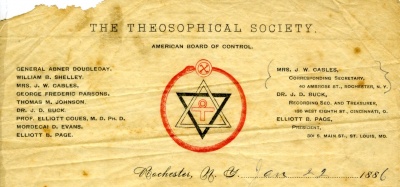User:SysopJ/My sandbox
ARTICLE UNDER CONSTRUCTION
ARTICLE UNDER CONSTRUCTION
Josephine Cables was one of the most influential American members of the Theosophical Society in its early days as a cofounder of the Rochester Theosophical Society.
Personal life
Josephine Warner married James Harvey Cables.....
William F. Aldritch joined the Gnostic Lodge of Washington, D.C. on October 15, 1885.[1]
Theosophical Society involvement
Rochester Theosophical Society
On July 27, 1882, Mrs. Cables was a co-founder of the Rochester Branch, which was the first lodge established in the United States. The first issue of William Quan Judge's periodical The Path said of Rochester, "This is the elder brother in America."[2] William B. Shelly served as president, and Mrs. Cables was secretary.[3] Her husband James Harvey Cables was among thirteen others who applied for the charter.[4] For several years before the lodge was formed, Mr. Shelly and Mrs. Cables had gathered with a group of friends to study "problems presented to thinking minds in life and death."[5]
The lodge grew to at least 25 members, including Matilda Joslyn Gage, a remarkable feminist and mother-in-law of L. Frank Baum. She was admitted to the Rochester Theosophical Society on March 26, 1885.[6][7] Another member who joined on Jun 11, 1884 was George C. Bragdon, father of Claude Bragdon.[8] The Bragdon family was prominent in several Rochester lodges, including Genesee, White Lotus, and Iris, and established the Manas Press.
The Rochester Branch seems to us to be, in this country at least, the vital centre of Theosophy. No members are admitted to that branch unless in the opinion and knowledge of its officers they are worthy and striving diligently to make themselves more worthy by pure lives and kind actions, pure thoughts and worthy deeds.
We are especially impressed with the beauty of character and the wonderul working capacity of Mrs. J. W. Cables, the secretary. She seems gifted with a remarkable penetration amountin to prescience, enabling her to read the minds and history of all with whom she comes in contact abnd to tell them what they are to expect, and what they may be able to accomplish in the future by their own labors if they will. She was the first of all Theosophists at Rochester and has now gathered a faithful company of co-workers about her to the number of about forty. She could have many more members if she were at all indifferent as to the character of all those who offer themselves. But she prefers purity to the fictitious strength to be realised from mere increase of number. We did not see Mr. Shelley the worthy and venerable President of the Branch as he was absent from home. The Society is sorely persecuted and tried by its enemies – The enemies of Theosophy. But probably not more so than other branches. The beauty of all this is that they make a perfect triumph at every point of attack. In all these labors Mrs. Cables is the moving and diving spirit knowing just what to do and how to do it. And under her leadership it is inspiring and beautiful to see how kindly and harmonious they all work together.[9]
American Board of Control
The American Board of Control was constituted on May 13, 1884 by "Special Order" of President-Founder Henry Olcott, then in India, to establish central management of the American branches of the Theosophical Society. Mrs. Cables was took on the role of corresponding secretary; Elliott B. Page of St. Louis was President; and Dr. J. D. Buck served as recording secretary and treasurer. Other Board members were Abner Doubleday, William B. Shelley, George Frederic Parsons, Thomas Moore Johnson, and Mordecai D. Evans. Professor Elliott Coues was also a member for a time.
The Board of Control held a convention in July, at Rochester, N. Y., when various matters relating to admission of members and other details of organization were discussed. In accordance with a resolution passed on June 6th by the Executive Council, Adyar, the Board was then dissolved.[10]
Theosophical Society in Aldrich, Alabama
Mrs. Cables established the Gita Theosophical Society in the small coal-mining town of Aldrich, Alabama, in 1886 as the twelfth American branch of the Theosophical Society. It was never large, and dissolved on September 29, 1887.[11]
Hermetic Brotherhood of Luxor
Writings
The Union Index of Theosophical Periodicals lists six articles by or about Mrs. Cables. The contents of her journal The Occult Word are not included in the index; issues are quite rare.
Mrs. Cables conducted a large correspondence with such people as William Quan Judge, Damodar K. Mavalankar, and Thomas Moore Johnson.
Notes
- ↑ Theosophical Society General Membership Register, 1875-1942 at http://tsmembers.org/. See book 1, entry 3465 (website file: 1B/15).
- ↑ "Theosophical Activities" The Path 1.1 (April, 1886), 30.
- ↑ A. E. S. Smythe, "Editorial Notes" The Lamp 4.6 no. 42 (August, 1900), 181.
- ↑ Theosophical Society General Membership Register, 1875-1942 at http://tsmembers.org/. See book 1, entries 1286-1287 (website file: 1A/42).
- ↑ "Theosophical Activities" The Path 1.1 (April, 1886), 30.
- ↑ Theosophical Society General Membership Register, 1875-1942 at http://tsmembers.org/. See book 1, entry 3274 (website file: 1B/11).
- ↑ See A Notable Theosophist: L. Frank Baum by John Algeo.
- ↑ Theosophical Society General Membership Register, 1875-1942 at http://tsmembers.org/. See book 1, entry 3048 (website file: 1B/6) for George Bragdon.
- ↑ "The Rochester Theosophical Society" The Theosophist Supplement Vol. 6 (December, 1885), 162.
- ↑ A. J. Cooper-Oakley, "NAME OF ARTICLE," General Report of the TS or Theosophist??? (January, 1887), ???.
- ↑ The Theosophist (April, 1888).
